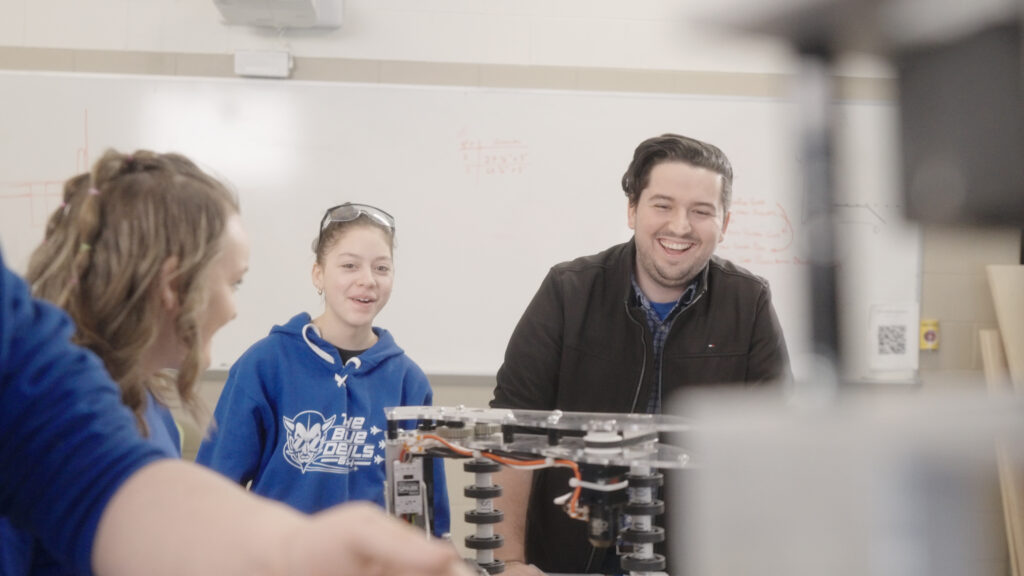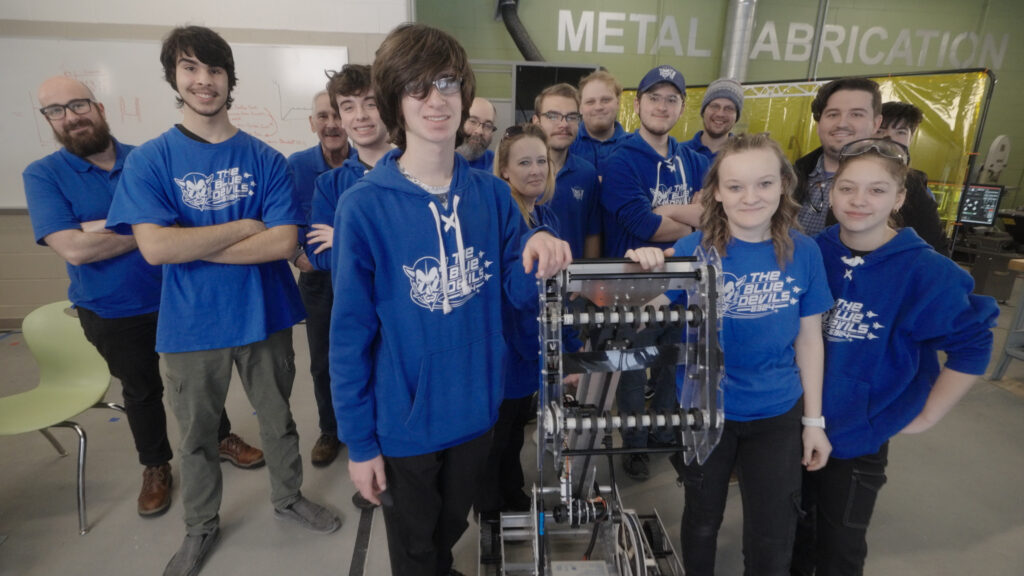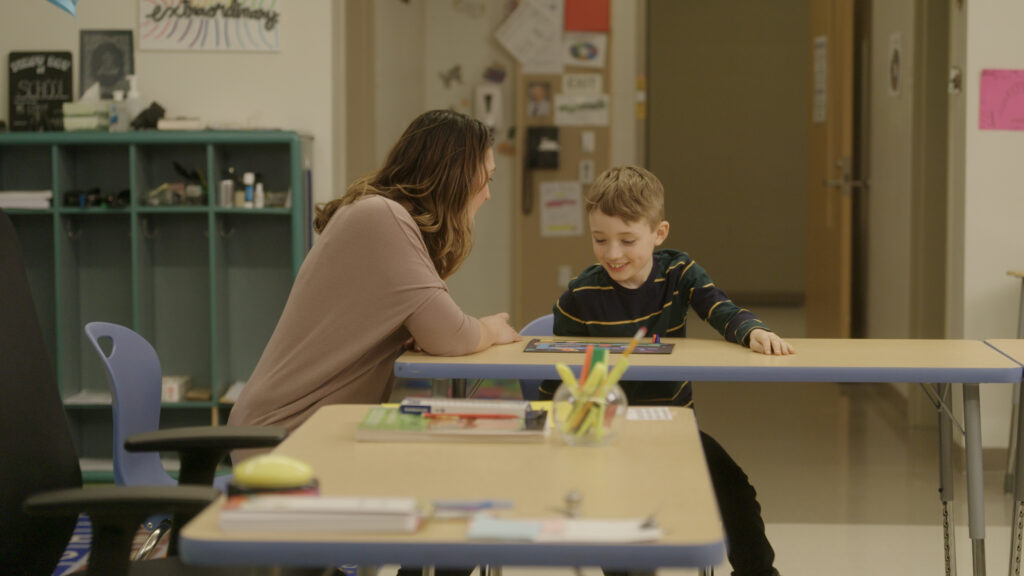Filming Involves Students, Parents, and Educators from Salem
Early on a Saturday morning in late February, a professional production crew crew and all their equipment descended on Salem High School. Their goal was to obtain footage for NEA-NH’s upcoming media campaign to increase our visibility in the state. Starting with two simple scripts and working with David Halpin from the Salem School District Communications and IT department, we recruited more than 20 students, educators, and parents to appear in the commercials. After unpacking and setting up the lights, make-up, break room supplies, microphones, and numerous cameras in the CTE area of the school, work began.

Stories That Must Be Told
In the heated environment now surrounding public education, the critically important work our public schools do is purposely being devalued by those bent on bringing culture wars to our classrooms. Our media campaign is designed to bring to the public’s attention the countless success stories found in every school in our state, and to the dedication and professionalism of our educators. When completed, the commercials will run on WMUR, streaming services and digital outlets, as well as YouTube and other social media platforms. In all, the grant allows us to spend more than $250,000 on creating and placing the ads.
“The Coolest Classes, and They’re Worth College Credit, Too!”
The engineering suite at Salem High School embodies any typical engineering lab with coffee machine and fridge, 3D printers, plasma cutter, CNC lath and workbenches lined with soldering irons and tools of every kind. Rolls of duct and double-sided tape can be found everywhere because they are every engineer’s go-to problem solver.
The lab is designed to feel and function as any found outside of the school, especially those that many of the students hope to find themselves working in one day. It is home to the Engineering and Architecture classes offered by SHS and to their FIRST Robotics team, FRC Team 6324.
The robot the team is building for this month’s Granite State District competition is called the Reaper, not because it’s designed to create destruction or mayhem, it just looks as if it is very capable of doing so.
Members of the FIRST Team and Engineering students filled the lab and used Saturday as another work day on their robot. Working around the crew, they managed to appear in the filming and advance the state of their robot. Some of them shared their thoughts on the team, their classes and their future.
Natalie is a freshman and wants to be an engineer. She’s taking engineering classes at SHS and is only one of a few girls in the class. She was told that the “robotics team had more girls on it” and she joined this year. She says her favorite part of being on the team is “watching the things they build get put together, and seeing everyone contribute to the effort and finished product.” She doesn’t know what type of engineer she wants to be yet, but she smiles broadly as she describes her future.
Haley has been on the Salem FIRST team for two years and joined because of a “family rivalry.” She is trying to beat her father’s team, a team that has “a lot of wins, a lot,” she says. She plans on going to college and then wants to become a teacher because “teaching is something I’m really passionate about.”
Mateo is a junior and has been on the team for 3 years. To him, CTE has “some of the coolest stuff and it’s worth college credit, too.” He plans on going to college for robotics engineering, specializing in software, which also happens to be his role on the team. Not doing well at the competitions doesn’t bother him. “Even though we failed really hard at the last competition, we learned a lot that will help us going forward.”
Ben, a junior, focuses on public relations, creates the FRC Team 6324 Newsletter, interacts with the team’s corporate sponsors, and helps ensure events are well publicized. He hopes to combine his creative side and engineering in the future. “I really enjoy watching the robot I helped build in action during the competitions.”

When Our Students Succeed, New Hampshire Succeeds
The experiences of the engineering students at SHS helped create the script for their teacher and team leader, Mr. S., to read:
First comes learning how things work, fit together. We formulate a hypothesis. Research. Ask questions. Brainstorm. Spark ideas. Experiment. Then build — piece by piece, fiber by fiber. We test, we fail, we rework, we grit our teeth, and we try again. Keep at it until we get it right. As public school educators, we’re building more than robots. We’re helping students build for their future. Helping make their dreams a reality. Because when they succeed, New Hampshire succeeds.
John Seeman graduated from Clarkson University in 2015 and worked for a year in a Houston school district after friends and colleagues told him he had a talent working with students. Originally from the northeast, he missed the area and started looking for a position closer to home. John learned about the Engineering opening in Salem and applied. He quickly got the job and we found him 7 years later in his newly built engineering lab, classroom and workspace overseeing the work on the robot and ready to give his lines to camera.
The engineering courses at SHS and other high schools with CTE programs in the state, introduce students to engineering design principles teaching them to digitally model and physically create objects using advanced computer design software, 3D printers, and machinery techniques in the fabrication lab. Students learn techniques for testing and analysis and focus on developing interpersonal and team-based skills essential for career and college success.
An Amazing Partnership Makes All the Difference
Jackson’s mom did not hesitate when Dave Halpin contacted her about the ads. She is an active advocate for her son and helped develop the script to share the story of the remarkable relationship they have with Jackson’s teacher, Jennifer Fitzsimons, aka Mrs. Fitz.
Children with attention-deficit/hyperactivity disorder (ADHD) experience more obstacles in their path to success than the average student. The symptoms of ADHD, such as inability to pay attention, difficulty sitting still, and difficulty controlling impulses, can make it harder for children with this diagnosis to do well in school.
According to Dr. Zentall, professor of Special Education at Purdue University, children with ADHD seek change, novelty and high-interest activities. They do best with an engaging active curriculum at school and an active home environment. Incorporating physical movement and motor activity throughout the day increases successes. When involved in a cognitive activity, children with ADHD often benefit from choices rather than solely adult-directed tasks. With their innate curiosity, these kids have a great potential for learning.

Caring, dedicated educators like Fitzsimons take the time to incorporate these principles into the classroom to ensure every student has the opportunity to succeed.
The script for Jackson’s story, read by his mom to camera, reads:
With his ADHD, Jackson learns a little differently than other kids. And going into 3rd grade, I was worried he might have trouble. But then we met Ms. Fitz. She worked with us on a plan to give him short breaks during the day and more time to complete his assignments. We’re always in touch, figuring out what Jackson needs to be successful. I’m so thankful for public school teachers like Mrs. Fitzsimons. It’s been an amazing partnership, and for Jackson, it’s made all the difference.
Jackson was the star of the afternoon’s filming and his connection to Mrs. Fitz was evident to everyone in the room. Working on math lessons, reading, or playing games, he enjoyed spending time with his favorite teacher and hardly seemed to care that the room was crowded with thousands of dollars of equipment and a film crew. Together with Mrs. Fitz, the connection every educator strives to make with their students was on full display.
Media Grant Helps Get the Message Out Across the State
The specific mandate from the NEA is that state media grant funds are intended: “to advance the cause of public education and publicize the role of the Association and its affiliates in improving the quality of public education.”
These funds are to proactively “advance the Association’s mission through image and reputation campaigns that strengthen the Association’s image among key audiences and the public.”
Public schools exist in every municipality and county in our nation for a reason. Historically, we have always agreed that education is critical to our children’s future, our economy, and the long-term health of our nation. So, we promised to share the cost of ensuring a high-quality public education to every child – no matter where they live, the color of their skin, or how much money their parents make. This was the promise we made to the children of every family in our community, the promise of public education.
Today in New Hampshire it is clear that we’re not living up to that promise. Funding for public K-12 education is both inadequate and inequitable. Our schools rely far too much on local property taxes, shortchanging students in property poor towns.
We ask so much of our public-school teachers, paraprofessionals, and staff. But instead of treating them like professionals – paying them well, listening to them, and giving them the support they need – we impose extreme accountability measures that punish them for factors they cannot possibly control, and then say the problem is too big to solve.
By every measure, New Hampshire’s public schools are doing a great job and we want to be sure more people know it. Look for the ads to appear in March on WMUR, streaming services, and online. You can view the ads by clicking the buttons below:
